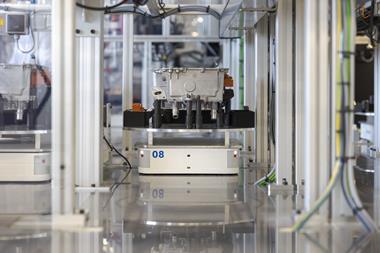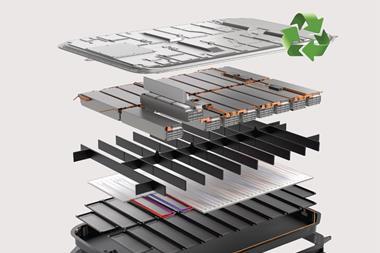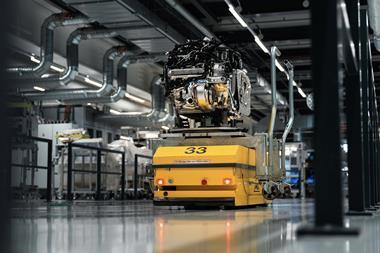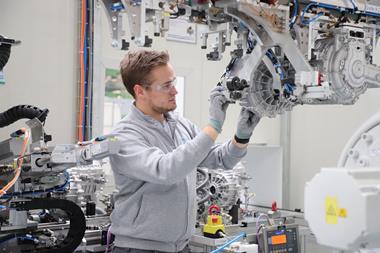
JBT explains how, with the widespread establishment of new production lines for electric vehicles, OEMs can redefine what automotive manufacturing looks like – AGVs present a particularly smart opportunity
 As an AGV supplier with a lot of experience in the automotive industry, we have watched electric vehicles shift from a pipe dream among environmentalists into real products that benefit consumers. The electric vehicle movement is exciting and presents a new vantage point from which we can examine the automotive manufacturing process. Whenever a conversation surrounding specifically electric vehicle manufacturing arises, discussion of similarities and differences between these cars and traditional, combustion-powered ones naturally results.
As an AGV supplier with a lot of experience in the automotive industry, we have watched electric vehicles shift from a pipe dream among environmentalists into real products that benefit consumers. The electric vehicle movement is exciting and presents a new vantage point from which we can examine the automotive manufacturing process. Whenever a conversation surrounding specifically electric vehicle manufacturing arises, discussion of similarities and differences between these cars and traditional, combustion-powered ones naturally results.
In our experience, after having spent significant time studying both processes in depth, we have noticed that these two methods of production share more similarities than differences. Powertrain facilities still provide the components to generate power. Body shops still craft all of the panels. Assembly plants still bring all of these parts together in order to build the car. Overall, nothing really differs.
However, as more and more manufacturers look to develop assembly lines capable of building several models along the same line, the addition of electric vehicles – both purely electric and hybrid versions – further increases complexity, which already lends itself to human error.
As JBT automotive applications engineer Mike Rafail notes, “Anytime complication is introduced into the manufacturing process, the risk of someone making a mistake increases, which is completely understandable.” After all, even if some electric vehicles require fewer parts in assembly, including these SKUs multiplies the number of parts and the number of locations in which they are stored.
Although many lift truck drivers now have technology inside their vehicles that help them do their jobs more effectively, these individuals still need to mentally keep track of all the storage locations within a given facility. Even a two-second delay can add up over time and result in significant time lost and potentially unnecessary costs.
As a result of this added complication and the ensuing demand on these drivers, automation seems to be more beneficial than ever in an industry already very familiar with it. Rafail points out that equipment like automated guided vehicles (AGVs) present a particularly good opportunity in this regard, as AGV systems handle complication in an effective manner.
Rafail says: “The nice thing about AGV systems is that they don’t even notice when there is additional system complication. As the vehicles communicate with higher-level software like ERP systems, the AGVs just do the work. They don’t need to take the extra time to think about where new SKUs are stored. They just go to the required location.”
By automating lineside supply in particular, AGVs help assembly lines respond to changes. For example, when a line needs to shift from production of large, combustion-powered cars to electric sedans, AGVs deliver the correct sub-assemblies or parts to the point-of-use. All that is required is notification within higher-level software. Once these few clicks are made by a system or assembly-line supervisor, the AGV responds and goes to the appropriate locations in order to pull the correct SKUs. Delays are eliminated, and the chances of errors occurring are reduced to virtually zero percent.
Aside from the benefits of AGVs supporting parts deliveries to lineside, these systems can also track inventory. As a result, AGVs not only move the correct loads to the right place but also know the inventory attributes of what they are carrying. Because of this, anyone monitoring the system or looking to optimise production based on data output will receive accurate, up-to-date information. Users can also schedule system activity, which enables them to pre-plan an entire day along one of these multiple-model assembly lines.
In fact, the software aspect of AGV systems seems to be perhaps even more advantageous than the benefits of reduced human error. Rafail adds, “More and more often, customers are coming to us because our systems provide quantifiable insight into their operations. They know that AGVs will offer visibility into their material handling, which, for many, is the final automation frontier that they have left to encounter. These endeavors support flexible assembly lines as well as Industry 4.0 initiatives.”
Along with increased human error, a higher potential for a safety incident may result from additional complexity. Once again, automation can offer a solution to this problem. “Improved safety has always been a driver of AGV systems within the automotive industry,” Rafail says. “Those who are hoping to achieve fork-free environments in particular have expressed interest in AGVs for the past twenty years or so. These vehicles reliably make facilities of all types safer places to work.”
Both combustion-powered cars and electric ones can trust that if they choose to add complexity into their operations, they will produce more accurate, more visible, and safer facilities.
For some of the new electric vehicle manufacturers, who do not have the same institutional knowledge of automation or the same refined practices of established suppliers, there is also an opportunity to redefine what automotive manufacturing looks like.
These suppliers can implement automation from the very start of the development of their material flow instead of incorporating it once these procedures have been established. As a result, there could be a paradigm shift within the industry, especially when these changes are viewed with the lens of Industry 4.0 strategies. In a few years, new body, powertrain, and assembly plants may look nothing like they have in the past.www.jbtc.com
































